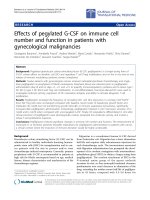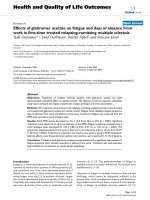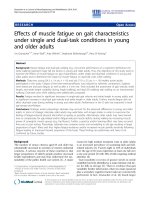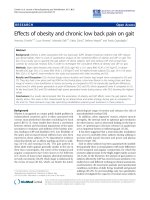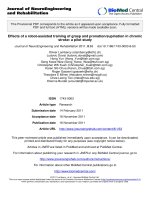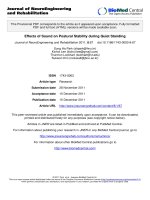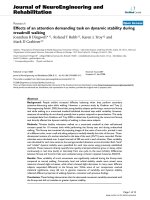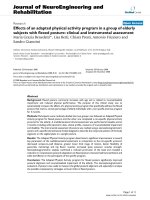Báo cáo hóa học: " Effects of low-temperature capping on the optical properties of GaAs/AlGaAs quantum wells" doc
Bạn đang xem bản rút gọn của tài liệu. Xem và tải ngay bản đầy đủ của tài liệu tại đây (343.22 KB, 4 trang )
NANO EXPRESS Open Access
Effects of low-temperature capping on the optical
properties of GaAs/AlGaAs quantum wells
Masafumi Jo
*
, Guotao Duan, Takaaki Mano, Kazuaki Sakoda
Abstract
We study the effects of low-temperature capping (200-450°C) on the optical properties of GaAs/AlGaAs quantum
wells. Photoluminescence measurements clearly show the formation of abundant nonradiative recombination
centers in an AlGaAs capping layer grown at 200°C, while there is a slight degradation of the optical quality in
AlGaAs capp ing layers grown at temperatures above 350°C compared to that of a high-temperature capping layer.
In addition, the optical quality can be restored by post-growth annealing without any structural change, except for
the 200°C-capped sample.
Introduction
Self-assembled semiconductor nanostructures have
attracted tremendous interest due to their excellent
electronic and optical properties. Since the properties of
nanostructures strongly depend on their size, shape, and
composition, it is important to reduce the morphologi-
cal change of nanostructures during the capping pro-
cess. In this context, much research has recently focused
on low-temperature capping with less atomic intermix-
ing, although it is commonly believed that the crystalline
quality of the capping layer deteriorates quickly with
decreasing temperature.
Droplet epitaxy is a self-assembled growth technique
based on the formatio n of metallic droplets followed by
crystallization into s emiconductor quantum dots (QDs)
[1-13]. Droplet epitaxy allows the self-assembly of QDs
in lattice-matched systems such as GaAs/AlGaAs, which
is unattainable in a conventional Stranski-Krastanow
growth mode. In the growth of GaAs/AlGaAs QDs, var-
ious quantum structures such as monomodal dots [3],
single/multiple rings [4,8,9], an d nanoholes [10-13] have
been derived by controlling the As pressure and tem-
perature during the crystallization of Ga droplets.
However, in droplet epitaxy, low-temperature pro-
cesses at around 200°C are required for the formation of
droplets and their crystallization, which often causes
degradation of the crystalline and optical qualities of the
QDs and subsequent AlGaAs capping layer. Uncapped
annealing of QDs is, therefore, used as an effective way
to impr ove the quality of the QDs [14]. This annealing
step, however, can also cause significant morphological
changes in the QD. For example, GaAs QDs grown on
GaAs(001) substrates e longate in the [-110] direction
when annealed at temperatures higher than 400°C [15],
and so a capping temperature below 400°C is necessary
for embedding QDs with their original morphology
maintained. However, such a low temperature is chal-
lenging for the growth of high-grade AlGaAs, and
indeed, the effects of a low-temperature AlGaAs capping
layer on the optical properties of adjacent GaAs quan-
tum structures have not yet been clarified.
We studied the optical qualities of GaAs nanostruc-
tures capped with a low-temperature AlGaAs layer. To
clarify the effects of the ca pping layer, we used high-
quality GaAs/AlGaAs single quantum wells (QWs)
capped at various temperatures. Luminescence study
showed a clear difference between the sample capped at
200°C and the samples capped above 350°C, which is
explained by the incorporation of excess arsenic in the
AlGaAs grown at low temperatures (< 300°C).
Experimental procedures
Figure 1 shows the sam ple structure used in this stu dy.
High-quality 4-nm GaAs/AlGaAs single QWs were
grown on semi-insulating GaAs(001) substrates by mole-
cular beam epitaxy at 580°C. Then the substrate tem-
perature was low ered and the QWs were cappe d with
20-nm AlGaAs at 200, 350, 450, and 580°C. For the cap-
ping a t 350, 450, and 580°C, the growth rate was se t at
* Correspondence:
National Institute for Materials Science, 1-2-1 Sengen, Tsukuba, Ibaraki 305-
0047, Japan
Jo et al. Nanoscale Research Letters 2011, 6:76
/>© 2011 Jo et al; licensee Springer. This is an Open Access article distributed under the terms of the Creative Commons Attribution
License ( which permits unrestricted use, distribution, and reproduction in any me dium,
provided the original work is prope rly cited.
one monolayer (ML) per second and As
4
flux of 2 × 10
-5
Torr was used. Only for the capping at 200°C, we used
migration enhanced epitaxy (MEE) to assure smooth
growth [16]. The MEE sequence consisted of alternative
deposition of III-materials and V-materials: Al and Ga
for 1 s (1 ML s
-1
)andAsfor5s(2×10
-6
Torr). Note
that the above growth parameters were not optimized.
After the first capping, the substrate was heated to
580°C, and second capping laye rs (30-nm AlGaAs +
10-nm GaAs) were grown at 580°C for all samples.
During the growth, the surface state was monitored by
reflection high-energy electron diffraction (RHEED).
The optical properties of the samples we re investigated
in terms of photoluminescence (PL). PL s pectra were
taken at 6 K, using the 532-nm line of a frequency-
doubled Nd:YAG laser. The PL signals were dispersed
by a monochromator and detected by a cooled Si
charge-coupled device array.
Results and discussion
First, the surface morphology of t he AlGaAs capping
layer was investigated by RHEED imaging. Figure 2a
shows the RHEED pattern of the sample capped at 350°C.
The surface exhibits a clear c(4 × 4) reconstruction with
streaky features, indicating that a flat surface was obtained.
When we decreased the capping temperature to 200°C,
the diffraction image changed from c(4 × 4) to (1 × 1) as
showninFigure2b.However,thepatternremained
streaky, which suggests two-dimensional growth of the
capping layer at 200°C.
Although a good surface morphology was observed for
all samples, the optical quality varied greatly between
the samples as shown in Figure 3. Let us first focus on
the samples capped above 350°C in which sharp emis-
sion lines from the GaAs QWs were obtained. The QW
emission around 740 nm consists of two peaks corre-
sponding to different well thicknesses of 14 and
15 MLs, as is clearly resolved in the sample capped at
350°C. A constant linewidth of about 15 meV is
observed for all three samples, indicating that both the
incorporation of impurities at the interface and local
charging effe cts due to defects in the AlGaAs capping
layer are negligibly small. The optical quality of the
AlGaAs capping layer can be monitored by the PL
intensity of the QW. In the sample capped at 450°C, the
PL intensity is almost the same as that of the 580°C
sample. Even in the sample capped at 350°C, the inten-
sity still remains at almost 50% of that of the 580°C
sample. These results illustrate that reasonably high-
qualitycappingcanbeachievedabove350°Cforthe
optical emission from QWs, although the number of
nonradiative recombination centers might increase
slightly at 350°C.
In contrast, the sample capped at 200°C exhibits faint
emission around 718 nm, which is blue shifted by
60 meV compared to the QW emission from the sam-
ple capped above 350°C. The emission linewidth also
increases to 30 meV. We attribute this change to the
incorporation of excess As atoms into the AlGaAs
S.I GaAs(001) substrate
100-nm AlGaAs
4-nm GaAs Qw
20-nm AlGaAs
30-nm AlGaAs
200-580ºC
10-nm GaAs
580ºC
580ºC
Figure 1 Sample structure of a 4-nm GaAs/AlGaAs QW.An
AlGaAs capping layer of 20 nm was grown at different
temperatures of 200, 350, 450, and 580°C.
(a) 350°C (b) 200°C
[110][110]
Figure 2 RHEED patterns of an AlGaAs capping layer grown.
(a) at 350°C, and (b) at 200°C.
2.0x10
6
1.5
1.0
0.5
0.0
PL intensity (cps)
800750700650
Wavelength (nm)
580°C
6 K
GaAs QW
450°C
350°C
200°C, 1000x
Log PL intensity (arb. unit)
500400300200
Temperature (°C)
(
a
) (b)
10
7
10
6
10
5
10
4
10
3
Figure 3 PL properties of GaAs/AlGaAs QWs. (a) Low-
temperature PL spectra of 4-nm GaAs/AlGaAs QWs capped at
different temperatures. (b) Integrated PL intensity plotted as a
function of the capping temperature.
Jo et al. Nanoscale Research Letters 2011, 6:76
/>Page 2 of 4
capping layer during the low-temperature growth. It is
well known that GaAs grown at temperatures below
300°C becomes nonstoichiometric with an excess
of arsenic incorporated as a point defect in the Ga As
matrix [17,18]. The excess arsenic forms precipitates
when annealed at temperatures above 500°C, but
the epilayer is still highly nonradiative due to the
presence of residual point defects [19] or re sultant
metallic As clusters [20]. I n o ur case, the AlGaAs cap-
ping layer containing As clusters was developed dur-
ing the subsequent growth of the second capping
layer at 580°C. Not only does the annea led low-tem-
perature AlGaAs lay er act as a nonradiative p athway,
but the As clusters may modulate the QW poten-
tial, resulting in the i mperceptible emission with a
peak shift.
The differences in optical quality were further studied
by the excitation power dependence of the PL. Figure 4
plots integrated PL intensity as a function of the e xcita-
tion power. The PL intensities of the samples capped at
580 and 350°C increase l inearly (m = 1) with respect to
the excitation power, illust rating that radiative recombi-
nation dominates in both samples [21]. On the other
hand, the quadratic (m = 2) development observed
in the 200°C-capped sample is consistent with the fact
that the nonradiative decay channels are strongly active
in the capping layer.
Here we would like to compare our results with pre-
vious reports on the properties of GaAs grown at low
temperatures. Since the first report by Stall et al. [22]
that the electrical properties of GaAs were degraded
when grown below 480°C, many efforts have been made
to obtain good quality of GaAs at low temperatures.
Metze et al. [23] were able to grow good-quality GaAs
at 450°C by reducing the grow th rate to 0.2 μmh
-1
.
Missous and Singer [24] pointed out the superiority of
As
2
in reducing the concentrat ion of deep levels com-
pared to As
4
. By contrast, our growth condition was
“normal”, i.e., the growth rate was 1 μmh
-1
and an As
4
source was used. The difference is that the epilayer was
ver y thin and u ndop ed in our case. In fact, our purpose
is to embed nanostructures w ith little atomic diffusion,
and the thickness (volume) of the capping layer is very
small compared to that of the whole structure. Our
results show that a thin cappi ng layer does not signifi-
cantly lower the quantum efficiency of the embedded
nanostructure, even though the capping layer was grown
at a low temperature with a normal condition. Of course
the quality of the capping layer would be improved by
optimizing the growth conditions such as growth rate,
V/III ratio, and As species.
Finally, the effect of post-growth annealing was stu-
died. To improve the quality, we performed rapid ther-
mal annealing (4 min, N
2
ambient) on the 350°C-capped
sample. Figure 5 shows PL spectra of the sample
annealed at 700 and 800°C, along with the as-grown
one. The PL intensity increases with increasing anneal-
ing temperature, and eventually becomes equivalent to
that of the 580°C-capped sample. Furthermore, the peak
position and linewidth remain unchanged during the
annealing , indic ating no significant intermixing between
the GaAs QW and t he AlGaAs capping layer. Note that
such restoration of sharp emission from the GaAs QW
was not observed i n the 200°C-capped sample since the
10
0
10
1
10
2
10
3
10
4
10
5
10
6
10
7
Integrate
d
PL
i
ntens
i
ty
(
ar
b
. un
i
ts
)
0.01 0.1 1 10 10
0
Excitation
p
ower
(
arb. unit
)
m = 1
580°C
350°C
200°C
6 K
m = 2
Figure 4 Excitation power dependence of the integrated PL
intensity of the samples capped at 580, 350, and 200°C. Solid
lines denote the linear dependence ( m = 1) and the quadratic
dependence (m = 2), respectively.
7x10
5
6
5
4
3
2
1
0
PL
i
ntens
i
ty
(
cps
)
85
0
800750700650
Wavelen
g
th
(
nm
)
6 K
800°C
700°C
As grown
GaAs QW
Figure 5 6-K PL spectra of the 350°C-capped sample annealed
at different temperatures.
Jo et al. Nanoscale Research Letters 2011, 6:76
/>Page 3 of 4
excess As atoms are difficult to remove even after post-
growth annealing.
Conclusion
We have studied the effects of a low-temperature
AlGaAs capping layer on the optical properties of a
GaAs QW, using different capping temperatures of 200,
350, 450 , and 580°C. A lthough a good morphology was
obtained for all samples, there was a clear difference in
the optical qualities between the 200°C-capped sample
and the others. In the sample capped at 200°C, incor-
poration of excess arsenic f ollowed by the formation of
As clusters introduces many nonradiative recombination
centers in the AlGaAs capping layer, which greatly
reduces the PL from the QW. By contrast, the sample
capped above 350°C showed clear emission from the
QW, though a slight degradation in intensity was
observed with decreasing capping temperature. Except
for the 200°C-capped sample, the quality could be
restored to that of the 580°C-capped sample without
any structural change caused by post-growth annealing
at 800°C. These results clearly demonstrate that the cap-
ping temperature of 350°C is high enough to obtain a
quantum s tructure with high quantum efficiency, thus
paving the way for low-temperature capping of QDs to
suppress morphological changes and interdiffusion.
Abbreviations
ML: monolayer; PL: photoluminescence; RHEED: reflection high-energy
electron diffraction; QDs: quantum dots; QWs: quantum wells.
Acknowledgements
This study was supported in part by a Grant-in-Aid for Scientific Research
from the Japan Society for the Promotion of Science.
Authors’ contributions
MJ carried out the optical measurements, participated in the sequence
alignment and drafted the manuscript. GD performed the sample growth.
TM participated in the design and coordination of the study. KS participated
in the design of the study. All authors read and approved the final
manuscript.
Competing interests
The authors declare that they have no competing interests.
Received: 18 August 2010 Accepted: 12 January 2011
Published: 12 January 2011
References
1. Koguchi N, Takahashi S, Chikyow T: New MBE growth method for InSb
quantum well boxes. J Cryst Growth 1991, 111:688.
2. Koguchi N, Ishige K: Growth of GaAs Epitaxial Microcrystals on an S-
Terminated GaAs Substrate by Successive Irradiation of Ga and As
Molecular Beams. Jpn J Appl Phys 1993, 32:2052.
3. Watanabe K, Koguchi N, Gotoh Y: Fabrication of GaAs Quantum Dots by
Modified Droplet Epitaxy. Jpn J Appl Phys 2000, 39:L79.
4. Mano T, Kuroda T, Sanguinetti S, Ochiai T, Tateno T, Kim J, Noda T,
Kawabe M, Sakoda K, Kido G, Koguchi N: Self-Assembly of Concentric
Quantum Double Rings. Nano Lett 2005, 5:425.
5. Lee JH, Wang ZM, AbuWaar ZY, Salamo GJ: Design of Nanostructure
Complexes by Droplet Epitaxy. Cryst Growth Des 2009, 9:715.
6. Lee JH, Wang ZM, Kim ES, Kim NY, Park SH, Salamo GJ: Various Quantum-
and Nano-Structures by III-V Droplet Epitaxy on GaAs Substrates.
Nanoscale Res Lett 2010, 5:308.
7. Wang ZM, Liang B, Sablon KA, Lee J, Mazur YI, Strom NW, Salamo GJ: Self-
Organization of InAs Quantum-Dot Clusters Directed by Droplet
Homoepitaxy. Small 2007, 3:235.
8. Somaschini C, Bietti S, Koguchi N, Sanguinetti S: Fabrication of Multiple
Concentric Nanoring Structures. Nano Lett 2009, 9:3419.
9. AbuWaar ZY, Mazur YI, Lee JH, Wang ZM, Salamo GJ: Optical behavior of
GaAs/AlGaAs ringlike nanostructures. J Appl Phys 2007, 101:024311.
10. Heyn C, Stemmann A, Hansen W: Droplet epitaxy of GaAs quantum dots
on (001), vicinal (001), (110), and (311)A GaAs. J Cryst Growth 2009,
311:1839.
11. Li AZ, Wang ZM, Wu J, Xie Y, Sablon KA, Salamo GJ: Evolution of Holed
Nanostructures on GaAs (001). Cryst Growth Des 2009, 9 :2941.
12. Wang ZM, Liang BL, Sablon KA, Salamo GJ: Nanoholes fabricated by self-
assembled gallium nanodrill on GaAs(100). Appl Phys Lett 2007, 90:113120.
13. Wang ZM, Holmes K, Shultz JL, Salamo GJ: Self-assembly of GaAs holed
nanostructures by droplet epitaxy, Phys Status Solidi A. 2005, 202:R85.
14. Mano T, Abbarchi M, Kuroda T, Mastrandrea AC, Vinattieri A, Sanguinetti S,
Sakoda K, Gurioli M: Ultra-narrow emission from single GaAs self-
assembled quantum dots grown by droplet epitaxy. Nanotechnology
2009, 20:395601.
15. Jo M, Mano T, Sakoda K: Unstrained GaAs Quantum Dashes Grown on
GaAs(001) Substrates by Droplet Epitaxy. Appl Phys Exp 2010, 3:045502.
16. Horikoshi Y, Kawashima M, Yamaguchi H: Migration-Enhanced Epitaxy of
GaAs and AlGaAs. Jpn J Appl Phys 1988, 27:169.
17. Nolte DD: Semi-insulating semiconductor heterostructures: Optoelectroic
properties and applications. J Appl Phys 1999, 85:6259.
18. Kaminska M, Weber ER, Liliental-Weber Z, Leon R, Rek ZU: Stoichiometry-
related defects in GaAs grown by molecular-beam epitaxy at low
temperatures. J Vac Sci Technol B 1989, 7:710.
19. Look DC: On compensation and conductivity models for molecular-
beam-epitaxial GaAs grown at low temperature. J Appl Phys 1991,
70:3148.
20. Viturro RE, Melloch MR, Woodall JM: Optical emission properties of semi-
insulating GaAs grown at low temperatures by molecular beam epitaxy.
Appl Phys Lett 1992, 60:3007.
21. Fukatsu S, Usami N, Shiraki Y: Luminescence from Si
1-x
Ge
x
/Si quantum
wells grown by Si molecular-beam epitaxy. J Vac Sci Technol B 1993,
11:895.
22. Stall RA, Wood CEC, Kirchner PD, Eastman LF: Growth-parameter
dependence of deep levels in molecular-beam-epitaxial GaAs. Electron
Lett 1980, 16:171.
23. Metze GM, Calawa AR, Mavroides JG: An investigation of GaAs films
grown byMBE at low substrate temperatures and growth rates. J Vac Sci
Technol B 1983, 1:166.
24. Missous M, Singer KE: Low-temperature molecular beam epitaxy of
gallium arsenide. Appl Phys Lett 1987, 50:694.
doi:10.1186/1556-276X-6-76
Cite this article as: Jo et al.: Effects of low-temperature capping on the
optical properties of GaAs/AlGaAs quantum wells. Nanoscale Research
Letters 2011 6:76.
Submit your manuscript to a
journal and benefi t from:
7 Convenient online submission
7 Rigorous peer review
7 Immediate publication on acceptance
7 Open access: articles freely available online
7 High visibility within the fi eld
7 Retaining the copyright to your article
Submit your next manuscript at 7 springeropen.com
Jo et al. Nanoscale Research Letters 2011, 6:76
/>Page 4 of 4
